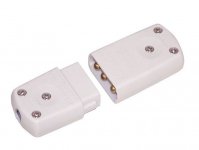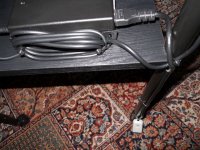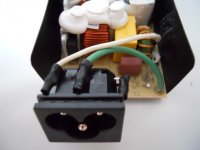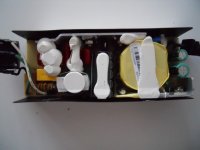Now, whilst everyone is reminiscing about 20th century storage methods there has been an announcement of a 512GB microSD card. Now for many (present company excepted) that would put an entire music collection on in 16/44.1 flac and even 24/96 would be at least 500 albums. You could put together a high resolution front end with all the music you would need and no internet connection required in something that fits in the palm of your hand. Now that's progress.
As jaded as we've all become with our myriad modern wonders, MicroSD cards can still make me a go a bit wide-eyed. They're the size of a fingernail, for god's sake.
Hi Frank,
Fair enough. I saw lot`s of ZX9 machines, and everything with the 480 transport. That first mechanism was fantastic, but it did have many maintenance issues. I think that for the average person, the second mechanism (BX series to CR series) is a little more reliable. Yes, those cam motors were a pain!
Like you, I am a Nakamichi fan for cassette decks. There was nothing out there that cam close to a three head Nakamichi that was correctly set up.
You still have the switch box! Yes, I guess you would. Mine went along with the shop, along with all the test tapes and jigs. All that stuff cost me $10K when I first opened as a Nakamichi warranty centre. It hurts to think of that stuff in the hands of the monkeys they have there now. I wonder how long the tapes lasted? Also the MRL test tapes.
-Chris
Fair enough. I saw lot`s of ZX9 machines, and everything with the 480 transport. That first mechanism was fantastic, but it did have many maintenance issues. I think that for the average person, the second mechanism (BX series to CR series) is a little more reliable. Yes, those cam motors were a pain!
Like you, I am a Nakamichi fan for cassette decks. There was nothing out there that cam close to a three head Nakamichi that was correctly set up.
You still have the switch box! Yes, I guess you would. Mine went along with the shop, along with all the test tapes and jigs. All that stuff cost me $10K when I first opened as a Nakamichi warranty centre. It hurts to think of that stuff in the hands of the monkeys they have there now. I wonder how long the tapes lasted? Also the MRL test tapes.
-Chris
Their peak meter (at least the one from the 550) was a very clever circuit, using only one transistor with a fast attack and a slow decrease time. Both accurate and agreeable to look-at.Like you, I am a Nakamichi fan for cassette decks.
I copied-it in my Revox machine.
Last edited:
What do you guys make of this 'fault' occurance.
Could a 'spark' between conductors cause conduction and a 3 amp mains fuse to rupture ?
A few days ago I 'hot connected' a laptop brick PSU via a its trailing lead connector (type as shown). I don't make a habit of doing this but have done it many times over the years... heck you have to make the circuit somewhere. It has been in daily use for 6 years but only gets hot connected/disconnected via this plug a few times a year at most.
The lead is correctly wired and has an earth core which carries through to the PSU. The PSU is of a type that has a 3 core lead as standard.
On this occasion there was a very substantial 'soft' yellow flash that seemed to jump a couple of cm from outside the connector at the moment the circuit was made. It startled me, that's for sure. There was a popping sound but not a sharp crack or bang.
Coinciding with this the incoming household 30ma earth leakage breaker tripped plunging everything into darkness. This breaker is on the incoming 100A supply.
Thinking the charger would be totally zapped and dead I rigged it up via bulb tester and powered it up. All normal. Output voltage spot on.
I connected it back to the trailing lead and found at this point that the 3A fuse in the plug top had ruptured. A new fuse and all was well. The lead and plug are in good condition.
Knowing this could be safety related I opened the PSU expecting to find perhaps a filter cap between line and ground had popped but nothing untoward showed with a visual inspection. There is also no leakage from either line pin to ground.
Any thoughts on what happened ? Could a normal little arc/spark of the normal variety you get when hot connecting something like this suddenly make the jump between L and E and conduct heavily somehow via the spark itself ?
Could a 'spark' between conductors cause conduction and a 3 amp mains fuse to rupture ?
A few days ago I 'hot connected' a laptop brick PSU via a its trailing lead connector (type as shown). I don't make a habit of doing this but have done it many times over the years... heck you have to make the circuit somewhere. It has been in daily use for 6 years but only gets hot connected/disconnected via this plug a few times a year at most.
The lead is correctly wired and has an earth core which carries through to the PSU. The PSU is of a type that has a 3 core lead as standard.
On this occasion there was a very substantial 'soft' yellow flash that seemed to jump a couple of cm from outside the connector at the moment the circuit was made. It startled me, that's for sure. There was a popping sound but not a sharp crack or bang.
Coinciding with this the incoming household 30ma earth leakage breaker tripped plunging everything into darkness. This breaker is on the incoming 100A supply.
Thinking the charger would be totally zapped and dead I rigged it up via bulb tester and powered it up. All normal. Output voltage spot on.
I connected it back to the trailing lead and found at this point that the 3A fuse in the plug top had ruptured. A new fuse and all was well. The lead and plug are in good condition.
Knowing this could be safety related I opened the PSU expecting to find perhaps a filter cap between line and ground had popped but nothing untoward showed with a visual inspection. There is also no leakage from either line pin to ground.
Any thoughts on what happened ? Could a normal little arc/spark of the normal variety you get when hot connecting something like this suddenly make the jump between L and E and conduct heavily somehow via the spark itself ?
Attachments
"Could a normal little arc/spark of the normal variety you get when hot connecting something like this suddenly make the jump between L and E and conduct heavily somehow via the spark itself ?"
I believe Yes.
I believe Yes.
By the nature of the yellow flash and 'popping' sound, I expect that some organic material ie lint etc was involved, causing an initial plasma/arc that effectively shorted all terminals together taking out the series fuse and tripping the earth leakage breaker.On this occasion there was a very substantial 'soft' yellow flash that seemed to jump a couple of cm from outside the connector at the moment the circuit was made. It startled me, that's for sure. There was a popping sound but not a sharp crack or bang.
Coinciding with this the incoming household 30ma earth leakage breaker tripped plunging everything into darkness. This breaker is on the incoming 100A supply.
What is the LNE order of the connecting pins ?.
Dan.
Last edited:
But whatever i did, the big Open Reel Tapes from Studer were better sounding than any cassette.
Regards
Frank
🙂 😎
-RNM
Hi Mooly,
I've heard of similar things happening with laptops over the years. Some causing serious damage. I don't know what has happened, but normally I would have said that it isn't possible.
What I think happened was that the switchmode power supplies on the motherboard started all together drawing extremely high current. In training classes on phone switches, we are always warned to plug the external power supply into the phone system first, then the mains. Same thing with our laptops. The internal power supplies should have been staggered in time for startup. Don't forget that they are trying to instantly charge all those huge capacitances on the secondary side. You might normally get away with plugging in the power supply first, but I can see where this could be a problem.
To this day I'll connect the external supply to the equipment first - then plug the external supply into the mains.
-Chris
I've heard of similar things happening with laptops over the years. Some causing serious damage. I don't know what has happened, but normally I would have said that it isn't possible.
What I think happened was that the switchmode power supplies on the motherboard started all together drawing extremely high current. In training classes on phone switches, we are always warned to plug the external power supply into the phone system first, then the mains. Same thing with our laptops. The internal power supplies should have been staggered in time for startup. Don't forget that they are trying to instantly charge all those huge capacitances on the secondary side. You might normally get away with plugging in the power supply first, but I can see where this could be a problem.
To this day I'll connect the external supply to the equipment first - then plug the external supply into the mains.
-Chris
Interesting...
Dan, the pin order is with E as centre. When the connector is pulled, the 'live' half sits on a (short) woollen carpet but its well vacuumed and non fluffy. The E pin protrudes a couple of mm more than the others so as to make first.
Chris, it was actually powering a laptop and the DC end of the PSU was connected to the lappy. I never encountered anything like this before tbh but whatever did occur tripped the ELCB and blew the fuse at the same time.
Dan, the pin order is with E as centre. When the connector is pulled, the 'live' half sits on a (short) woollen carpet but its well vacuumed and non fluffy. The E pin protrudes a couple of mm more than the others so as to make first.
Chris, it was actually powering a laptop and the DC end of the PSU was connected to the lappy. I never encountered anything like this before tbh but whatever did occur tripped the ELCB and blew the fuse at the same time.
Mooly, Is there is an AC line power transformer in there? Transformer inrush surges can happen depending on residual magnetization in the core from when it was last turned off. If the power is reconnected at the right time it can drive the core into hard saturation for a few cycles before it recovers, but its a statistical chance thing, it won't always happen. Some supplies use soft-start circuits to prevent the otherwise occasional surges.
Switched supplies can have huge inrush currents. The end connecting to mains is typically a bridge or a couple of diodes connected to a big cap, virtually creating a short circuit for a sub-millisecond period on switch-on. That explains the flash and the circuit breaker tripping. Only happens when your timing is just right.Could a 'spark' between conductors cause conduction and a 3 amp mains fuse to rupture ? <snip>
Last edited:
Its just a normal laptop PSU. Just looked again and the reservoir cap is a 100uF/420V radial, so pretty small really.
What Vacuphile says over timing seems a possible... I perhaps caught it at exactly the right (lol, or wrong) part of the cycle.
Whatever happened must have drawn a current over 3 amps to pop that plug top fuse and also found its way into the ground lead.
What Vacuphile says over timing seems a possible... I perhaps caught it at exactly the right (lol, or wrong) part of the cycle.
Whatever happened must have drawn a current over 3 amps to pop that plug top fuse and also found its way into the ground lead.
70 Amps cold start inrush current for a 90 Watt brick? Check.
GST90A-MEAN WELL Switching Power Supply Manufacturer
No complaints about MW, never saw one fail, but you do need precautions when switching more than a couple at the same time. Breaker panel mounted inrush current limiters is one solution, but not cheap.
GST90A-MEAN WELL Switching Power Supply Manufacturer
No complaints about MW, never saw one fail, but you do need precautions when switching more than a couple at the same time. Breaker panel mounted inrush current limiters is one solution, but not cheap.
Interesting, I've never seen that specified before for laptop charger.
So if we assume a high inrush occurred, and it created a bigger than normal spark as the pins connected, could that spark then 'jump' to the centre earth pin and pull a more sustained current. The internal fuse in the PSU is a tiny soldered T3.15A that looks like a miniature 0.01uF poly cap.
(talking of inrush currents, I worked a lot on Sony TV's and the degauss circuit pulled enough inrush current to very noticeably momentarily dim household lights and yet the internal fusing was typically T3.15 or T5A)
So if we assume a high inrush occurred, and it created a bigger than normal spark as the pins connected, could that spark then 'jump' to the centre earth pin and pull a more sustained current. The internal fuse in the PSU is a tiny soldered T3.15A that looks like a miniature 0.01uF poly cap.
(talking of inrush currents, I worked a lot on Sony TV's and the degauss circuit pulled enough inrush current to very noticeably momentarily dim household lights and yet the internal fusing was typically T3.15 or T5A)
"So if we assume a high inrush occurred, and it created a bigger than normal spark as the pins connected, could that spark then 'jump' to the centre earth pin and pull a more sustained current."
I could happen, but that only would effect the 100A fuse, which could have other load on it beside the laptop PS.
I could happen, but that only would effect the 100A fuse, which could have other load on it beside the laptop PS.
512gb in a thumbnail package! Far cry from the LEO II valve computers memory I worked on in the 1960's.
A whopping 2K of 39bit words made up a cabinet of mercury delay line tubes with 4 words per tube. We've come a long way.
A whopping 2K of 39bit words made up a cabinet of mercury delay line tubes with 4 words per tube. We've come a long way.
"So if we assume a high inrush occurred, and it created a bigger than normal spark as the pins connected, could that spark then 'jump' to the centre earth pin and pull a more sustained current."
I could happen, but that only would effect the 100A fuse, which could have other load on it beside the laptop PS.
Don't forget there is the main incoming 100A fuse, then a 30A breaker in the consumer unit, then the 3A plug top fuse and finally a 3.15 in the PSU.
My best guess at the moment is that a spark occurred on the live pin rather than the neutral (I'm assuming neutral connected first). That spark then somehow found its way to the centre earth pin, the spark acting somewhat like a lightning strike feeder trace, and that then allowing a high current to flow between L and E and pop the 3A plug fuse.
In future I will try and use the wall switch rather than hot connecting.
In future I will try and use the wall switch rather than hot connecting.
How would that be any different? The arc would occur inside the switch where you wouldn't see it?
Probably the only thing you could do that would make a difference is unplug the charger from the computer before plugging it into the wall. No load then, at least.
Hotplugging would be plugging the PS into the AC line with the PS power switch turned on (if it had one) or otherwise with it's load connected, wouldn't it?
- Status
- Not open for further replies.
- Home
- Member Areas
- The Lounge
- John Curl's Blowtorch preamplifier part II




